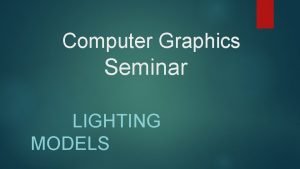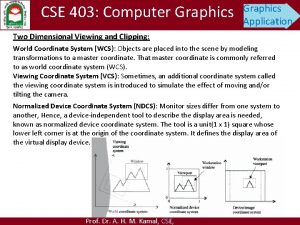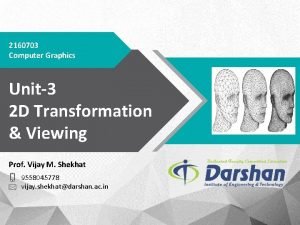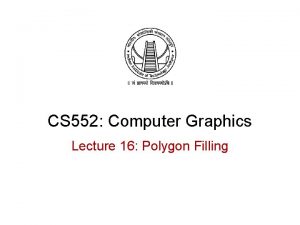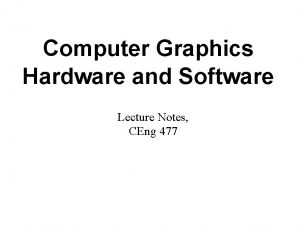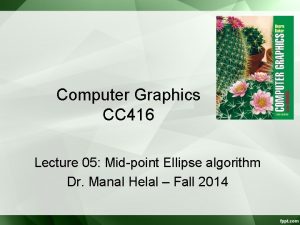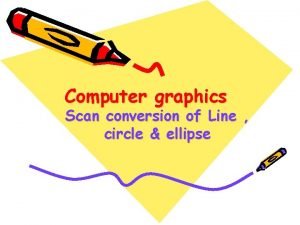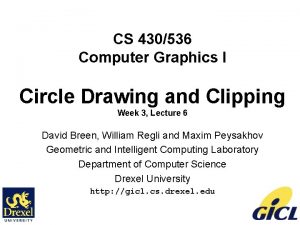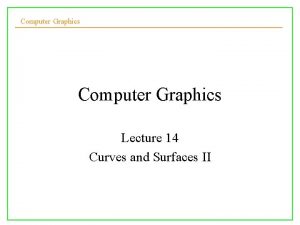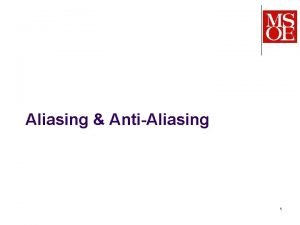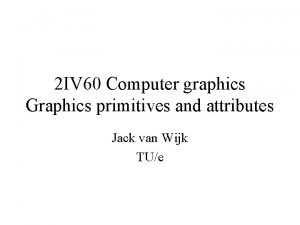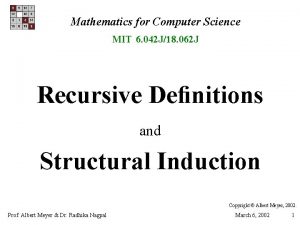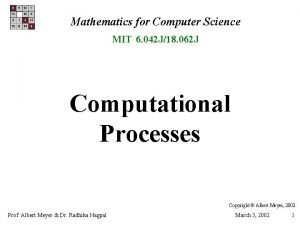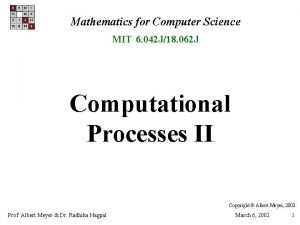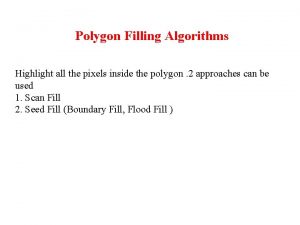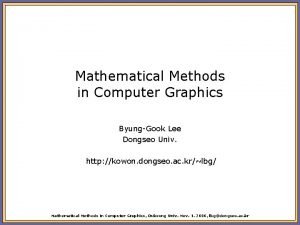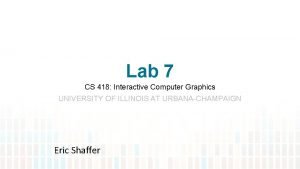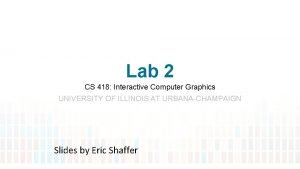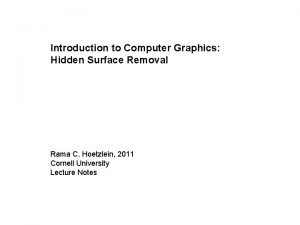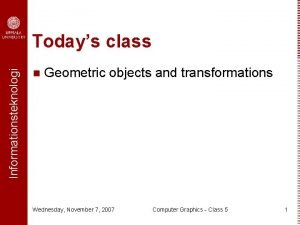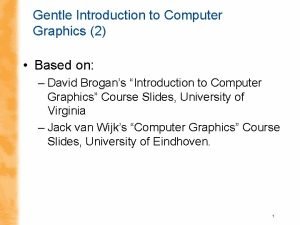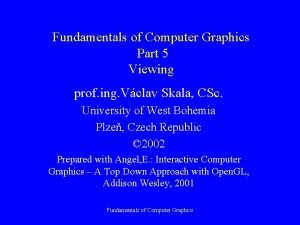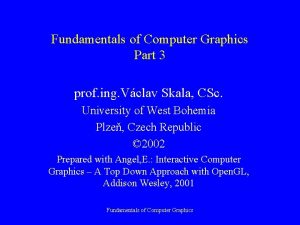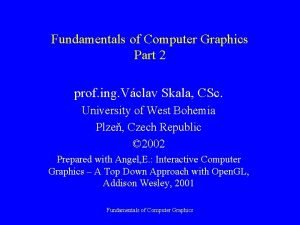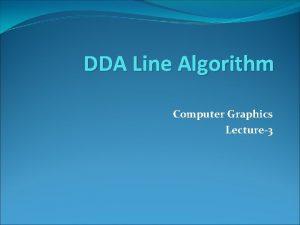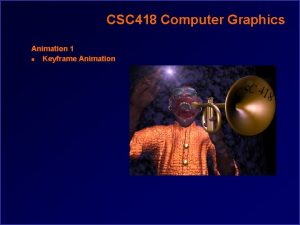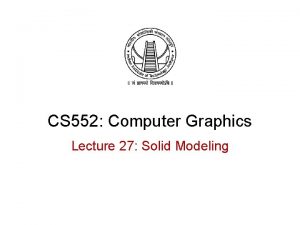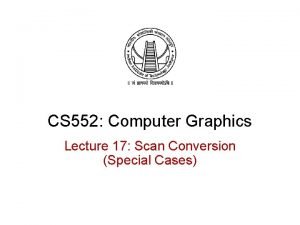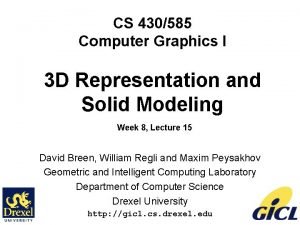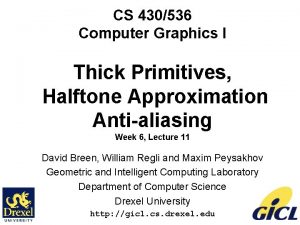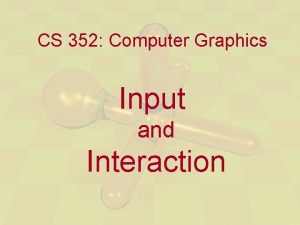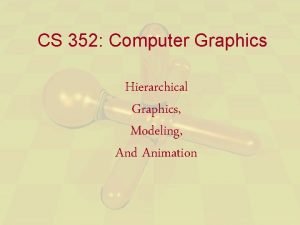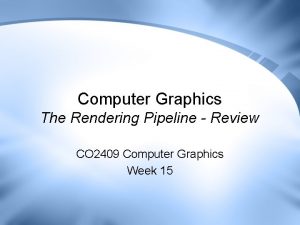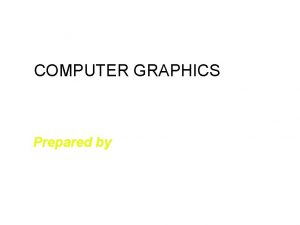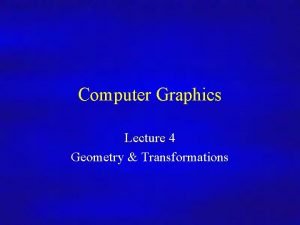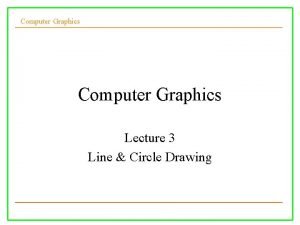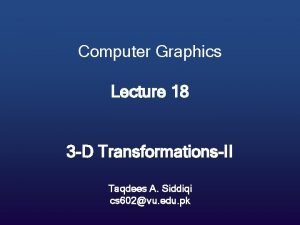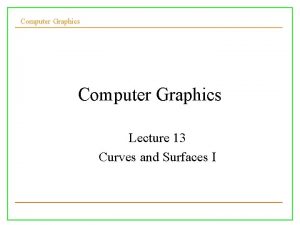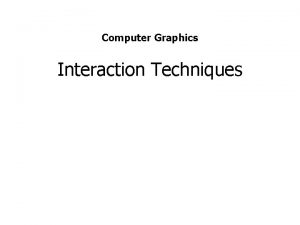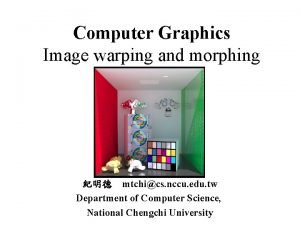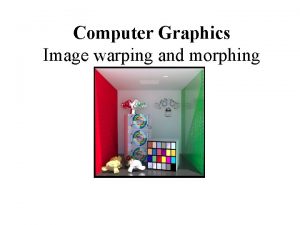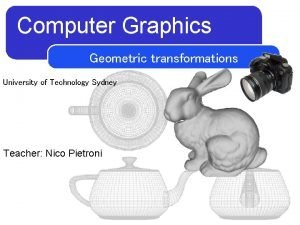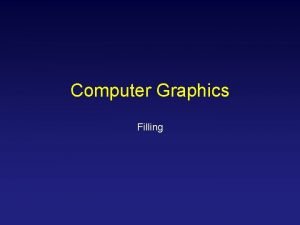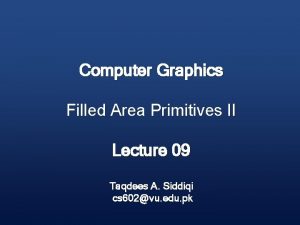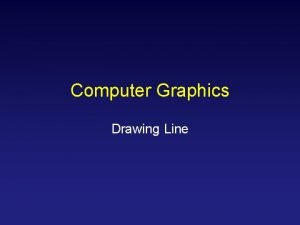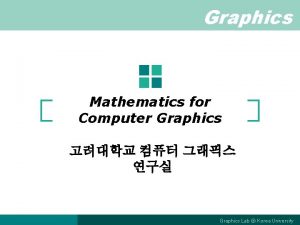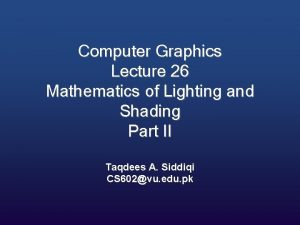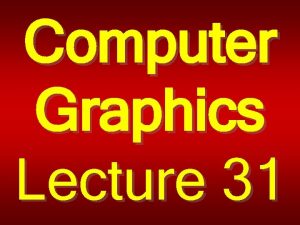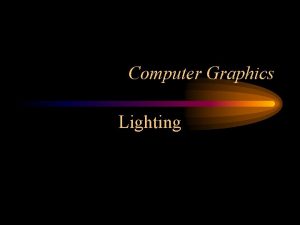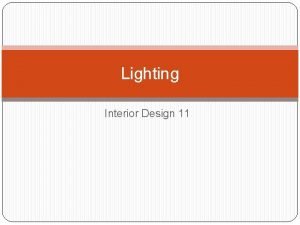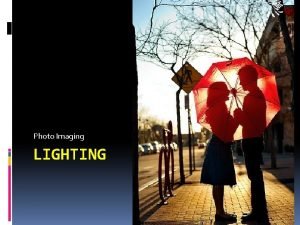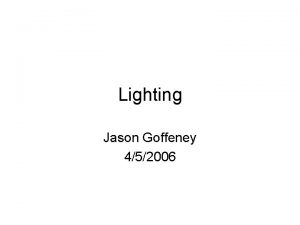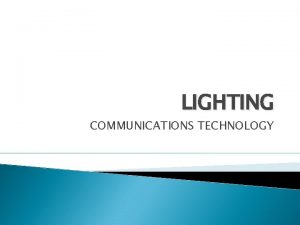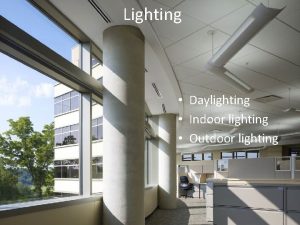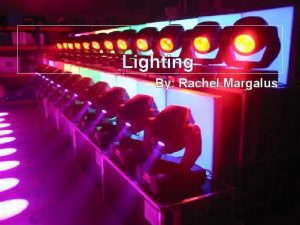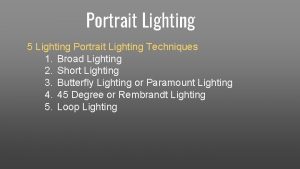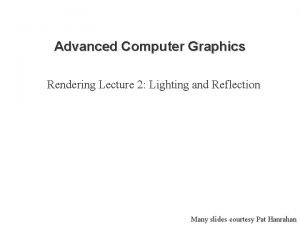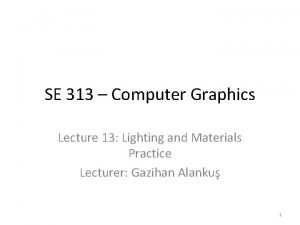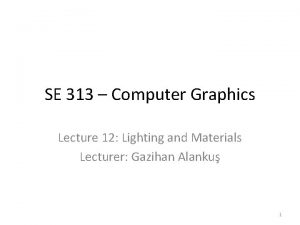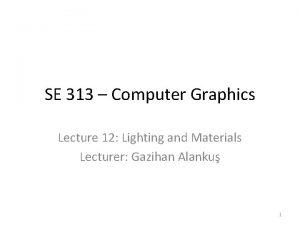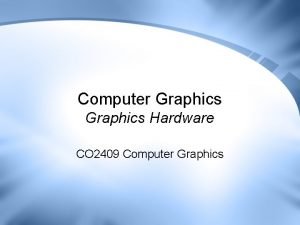Computer Graphics Lecture 29 Mathematics of Lighting and











![The reflection coefficients are in the [0, 1] range and are specified as part The reflection coefficients are in the [0, 1] range and are specified as part](https://slidetodoc.com/presentation_image_h2/f53db8c2c5994003815e6dc4e98b77f7/image-12.jpg)






































![Warnock [WARNOCK 1969] and Romney [ROMNEY 1969] were the first to try to simulate Warnock [WARNOCK 1969] and Romney [ROMNEY 1969] were the first to try to simulate](https://slidetodoc.com/presentation_image_h2/f53db8c2c5994003815e6dc4e98b77f7/image-51.jpg)
![But it wasn't until Phong Bui-Tong [BUI 1998] reformulated this into a more general But it wasn't until Phong Bui-Tong [BUI 1998] reformulated this into a more general](https://slidetodoc.com/presentation_image_h2/f53db8c2c5994003815e6dc4e98b77f7/image-52.jpg)






![The reflection coefficients are in the [0, 1] range and are specified as part The reflection coefficients are in the [0, 1] range and are specified as part](https://slidetodoc.com/presentation_image_h2/f53db8c2c5994003815e6dc4e98b77f7/image-59.jpg)













- Slides: 72

Computer Graphics Lecture 29 Mathematics of Lighting and Shading III Taqdees A. Siddiqi cs 602@vu. edu. pk

Mathematics of Lighting and Shading III Taqdees A. Siddiqi cs 602@vu. edu. pk

Traditional 3 D Hardware-Accelerated Lighting Models

We will now take a look at the traditional method of calculating lighting in hardware A method that we'll find is sufficient for most of our needs

The traditional approach in real-time computer graphics has been to calculate lighting at a vertex as a sum of the ambient, diffuse, and specular light.

In the simplest form (used by Open. GL and Direct 3 D), the function is simply the sum of these lighting components (clamped to a maximum color value).

we have an ambient term and then a sum of all the light from the light sources


where itotal is the intensity of light (as an rgb value) from the sum of the intensity of the global ambient value and the diffuse and specular components of the light from the light sources

This is called a local lighting model since the only light on a vertex is from a light source, not from other objects. That is, lights are lights, not objects!

we've included the reflection coefficients for each term, k for completeness.
![The reflection coefficients are in the 0 1 range and are specified as part The reflection coefficients are in the [0, 1] range and are specified as part](https://slidetodoc.com/presentation_image_h2/f53db8c2c5994003815e6dc4e98b77f7/image-12.jpg)
The reflection coefficients are in the [0, 1] range and are specified as part of the material property

This equation does fail to take into account any gross roughness or anything other than perfect isotropic reflection

the surface is treated as being perfectly smooth and equally reflective in all directions

Thus this equation is really not good at modeling the illumination of objects that have anything other than a smooth surface (like fur or sand)

or a surface that doesn't really reflect light uniformly in all directions (like brushed metal, hair, or skin).

However, with liberal use of texture maps to add detail, this model has served pretty well and can still be used for a majority of the lighting processing to create a realistic environment in real time

Let's take a look at the individual parts of the traditional lighting pipeline.

Ambient Light

Ambient light is the light that comes from all directions — thus all surfaces are illuminated equally regardless of orientation

Figure 1: Ambient light provides illumination, but no surface details.

We can see that it's difficult to make out details or depth information with just ambient light.

Ambient lighting is our friend. With it we make our scene seem more realistic than it is.

A world without ambient light is one filled with sharp edges, of bright objects surrounded by sharp, dark, harsh shadows.

A world with too much ambient light looks washed out and dull.

Diffuse Light

Diffuse light is the light that is absorbed by a surface and is reflected in all directions

In the traditional model, this is ideal diffuse reflection

This is good for rough surfaces where the reflected intensity is constant across the surface and is independent of viewpoint but depends only upon the direction of the light source to the surface

The regardless of the direction from which we view an object with a stationary diffuse light source on it, the brightness of any point on the surface will remain the same

Unlike ambient light, the intensity of diffuse light is directional and is a function of the angle of the incoming light and the surface

This type of shading is called Lambertian shading after Lambert's cosine law,

The law states that the intensity of the light reflected from an ideal diffuse surface is proportional to the cosine of the direction of the light to the vertex normal

Since we're dealing with vertices here and not surfaces, each vertex has a normal associated with it

Diffuse light decreases as the angle between the light vector and the surface normal increases.

Figure 2 shows the intensity of reflected light as a function of the angle between the vertex normal and the light direction.

The equation for calculating diffuse lighting is

Diffuse light term is now multiplied by the dot product of the unit normal of the vertex and the unit direction vector to the light from the vertex (not the direction from the light)

Diffuse light shading brings out some surface details

The problem with just diffuse lighting is that it's independent of the viewer's direction

Thus as we change the viewing angle to a vertex, the vertex's diffuse light value never changes

We have to rotate the object (change the normal direction) or move the light (change the light direction) to get a change in the diffuse lighting of the object

However, when we combine the ambient and diffuse, as in Figure 4, we can see that the two types of light give a much more realistic representation than either does alone

Ambient and Diffuse light together give a much better shading

Figure 4: When diffuse and ambient terms are combined, you get more detail and a more naturallooking scene. The final color is the combination of the ambient and diffuse colors.

Specular Light

Specular light is the light from a light source that is reflected by a surface and is reflected in such a manner that it's both a function of the light's vector and the viewer's direction.

Specular light's intensity follows the reflection vector.

Most discussions of lighting (including this one) start with Phong's lighting equation

Phong's Specular Light Equation
![Warnock WARNOCK 1969 and Romney ROMNEY 1969 were the first to try to simulate Warnock [WARNOCK 1969] and Romney [ROMNEY 1969] were the first to try to simulate](https://slidetodoc.com/presentation_image_h2/f53db8c2c5994003815e6dc4e98b77f7/image-51.jpg)
Warnock [WARNOCK 1969] and Romney [ROMNEY 1969] were the first to try to simulate highlights using a cos n (θ ) term.
![But it wasnt until Phong BuiTong BUI 1998 reformulated this into a more general But it wasn't until Phong Bui-Tong [BUI 1998] reformulated this into a more general](https://slidetodoc.com/presentation_image_h2/f53db8c2c5994003815e6dc4e98b77f7/image-52.jpg)
But it wasn't until Phong Bui-Tong [BUI 1998] reformulated this into a more general model that formalized the power value as a measure of surface roughness that we approach the terms used today for specular highlights

Phong's equation for specular lighting is


Figure 6: The relationship between the normal n, the light vector l, the view direction v, and the reflection vector r.

RECAP The traditional approach in real-time computer graphics has been to calculate lighting at a vertex as a sum of the ambient, diffuse, and specular light.


This is called a local lighting model since the only light on a vertex is from a light source, not from other objects. That is, lights are lights, not objects!
![The reflection coefficients are in the 0 1 range and are specified as part The reflection coefficients are in the [0, 1] range and are specified as part](https://slidetodoc.com/presentation_image_h2/f53db8c2c5994003815e6dc4e98b77f7/image-59.jpg)
The reflection coefficients are in the [0, 1] range and are specified as part of the material property

Let's take a look at the individual parts of the traditional lighting pipeline.

Ambient Light

Figure 1: Ambient light provides illumination, but no surface details.

Diffuse Light

Diffuse light decreases as the angle between the light vector and the surface normal increases.

The equation for calculating diffuse lighting is

Diffuse light shading brings out some surface details

Ambient and Diffuse light together give a much better shading

Specular Light

Specular light's intensity follows the reflection vector.

Phong's equation for specular lighting is


Computer Graphics Lecture 29
 Lighting models in computer graphics
Lighting models in computer graphics Graphics monitors in computer graphics
Graphics monitors in computer graphics Computer graphics chapter 1 ppt
Computer graphics chapter 1 ppt 01:640:244 lecture notes - lecture 15: plat, idah, farad
01:640:244 lecture notes - lecture 15: plat, idah, farad Interior and exterior clipping in computer graphics
Interior and exterior clipping in computer graphics Drawing algorithms
Drawing algorithms Dda algorithm in computer graphics ppt
Dda algorithm in computer graphics ppt In two dimensional viewing system have
In two dimensional viewing system have Shear transformation in computer graphics
Shear transformation in computer graphics Mathematical foundations of computer graphics and vision
Mathematical foundations of computer graphics and vision Points and lines in computer graphics ppt
Points and lines in computer graphics ppt Flood fill algorithm in computer graphics
Flood fill algorithm in computer graphics Hardware and software for computer graphics
Hardware and software for computer graphics Midpoint of an ellipse
Midpoint of an ellipse Direct use of line equation in computer graphics
Direct use of line equation in computer graphics Pixmap in computer graphics
Pixmap in computer graphics In random scan display, the frame buffer holds
In random scan display, the frame buffer holds Circle and ellipse drawing algorithm in computer graphics
Circle and ellipse drawing algorithm in computer graphics Curves and surfaces for computer graphics
Curves and surfaces for computer graphics Aliasing and antialiasing in computer graphics
Aliasing and antialiasing in computer graphics Filled area primitives in computer graphics
Filled area primitives in computer graphics Mathematics for computer science mit
Mathematics for computer science mit Mathematics for computer science mit
Mathematics for computer science mit Mathematics for computer science mit
Mathematics for computer science mit Computer security 161 cryptocurrency lecture
Computer security 161 cryptocurrency lecture Computer-aided drug design lecture notes
Computer-aided drug design lecture notes Computer architecture notes
Computer architecture notes Isa vs microarchitecture
Isa vs microarchitecture Angel
Angel Define viewing in computer graphics
Define viewing in computer graphics Plasma panel display in computer graphics
Plasma panel display in computer graphics Shear transformation in computer graphics
Shear transformation in computer graphics Shader computer graphics
Shader computer graphics Scan converting ellipse in computer graphics
Scan converting ellipse in computer graphics Rigid motion definition
Rigid motion definition Region filling can be performed in following approaches
Region filling can be performed in following approaches Dda algorithm advantages and disadvantages
Dda algorithm advantages and disadvantages Polygon filling algorithms
Polygon filling algorithms Computer graphics
Computer graphics Cs 418 interactive computer graphics
Cs 418 interactive computer graphics Cs 418 interactive computer graphics
Cs 418 interactive computer graphics Hidden surface removal algorithm in computer graphics
Hidden surface removal algorithm in computer graphics Achromatic light in computer graphics
Achromatic light in computer graphics Interactive input
Interactive input Uniform scaling in computer graphics
Uniform scaling in computer graphics Uniform scaling in computer graphics
Uniform scaling in computer graphics Fundamentals of computer graphics
Fundamentals of computer graphics Logical input devices in computer graphics
Logical input devices in computer graphics Fundamentals of computer graphics
Fundamentals of computer graphics Dda computer graphics
Dda computer graphics Keyframe system in computer graphics
Keyframe system in computer graphics Solid examples
Solid examples Scan conversion in computer graphics
Scan conversion in computer graphics Boundary representation in computer graphics
Boundary representation in computer graphics Thick primitives in computer graphics
Thick primitives in computer graphics Interaction in computer graphics
Interaction in computer graphics Computer graphics
Computer graphics Rendering pipeline in computer graphics
Rendering pipeline in computer graphics Srgp in computer graphics
Srgp in computer graphics Translation in computer graphics
Translation in computer graphics Dda circle drawing algorithm
Dda circle drawing algorithm Uniform scaling in computer graphics
Uniform scaling in computer graphics What are curves in computer graphics
What are curves in computer graphics Input of graphical data in computer graphics
Input of graphical data in computer graphics Edge table in computer graphics
Edge table in computer graphics Warping in computer graphics
Warping in computer graphics Amber
Amber Uniform scaling in computer graphics
Uniform scaling in computer graphics Polygon table in computer graphics
Polygon table in computer graphics Filled vs unfilled polygon in computer graphics
Filled vs unfilled polygon in computer graphics Computer graphics code for line drawing
Computer graphics code for line drawing Attributes in computer graphics
Attributes in computer graphics Objectives of computer graphics
Objectives of computer graphics
